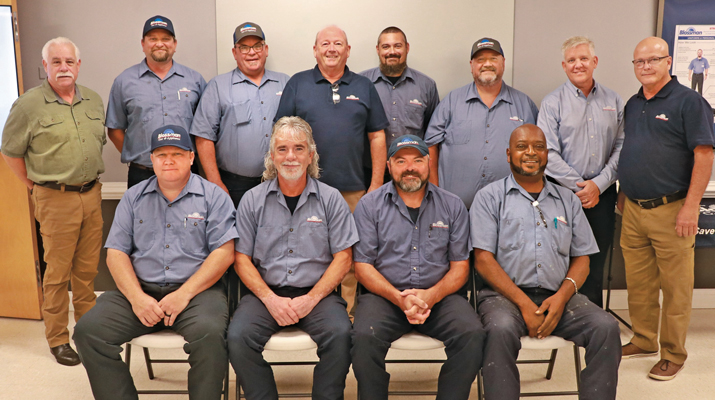LPG Spotlight: Blossman Gas

After three years of study, the first class of Blossman Gas master technicians became certified in September.
(Photo by Amanda McWilliams, Blossman Gas)
Matthew Volek was always a hard worker but for years struggled to find his professional niche. At one time or another, he was an HVAC installer, truck driver, carpet mill machinist and repairman.
Volek finally found his calling in 2016 when he landed a job at Blossman Gas. He initially applied for a bobtail driver position, but a Blossman aptitude test indicated that he would excel as a service technician, so that’s the job he accepted.
Now, thanks to a new, comprehensive and intensive training program at Blossman, Volek has become a certified master technician after acing the highest level of training the company offers. He’s one of eight Blossman employees who received this certification in September.
“It was exciting because we were the first master technicians Blossman ever had,” Volek says. “That was historic for the company. I loved the recognition, but it was also humbling for me.”
Scott Weatherford, Blossman’s director of safety and compliance, says the training program, launched three years ago, allows Blossman for the first time to award continuing education credits (CEUs) that are transferrable and recognized outside the company.
That’s because the Propane Education & Research Council (PERC), from which Blossman gets a significant chunk of training material, became accredited for its safety and training programs earlier this year. Previously, Blossman did award CEUs, but they were valid only within the Blossman world.
Weatherford says Blossman uses a blended approach of online, self-directed learning, in-person classroom instruction and on-the-job-training.
The program, he says, is more demanding, with new, accredited PERC coursework replacing CETP material, along with Blossman’s own curricula. It consists of three tiers of courses, with each tier taking about one year to complete, although students with prior knowledge and experience can test out of certain courses.
The first tier is service technician. The trained service tech is certified to perform exterior work like installing tanks, cylinders and regulators and running service lines. They can install, test and retrofit cathodic protection systems and test exterior systems for leaks.
The second tier is senior service technician. Techs at this level can handle both exterior and interior work, including installing pipes and setting up appliances. They learn the types of materials that can be used indoors and how to vent properly.
The third tier is master technician. These techs can do everything a senior tech can do, plus they’re certified in troubleshooting and are well-versed in electrical switches, computer boards, gas valves and safety and sensing devices. Master techs work in both homes and industrial plants and can convert appliances from natural gas to LP gas and vice versa.
Weatherford says that unlike the old training, the three-tiered program is modularized, meaning that in addition to basic, required courses, students can take elective classes that help them follow a particular career path.
Blossman offers the training only to its own 1,000 or so employees, including more than 200 service techs. But Weatherford sees a day when Blossman will open the program to technical schools and other companies, helping the entire industry recruit and retain labor.
Company profile: Blossman Gas
Year founded // 1951
Headquarters // Ocean Springs, Mississippi
Locations // 85 retail stores across 16 states
Annual propane gallons // 120 million
Employees // About 1,000 (200 service techs)
















